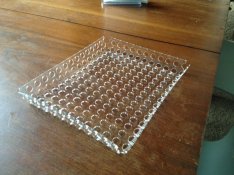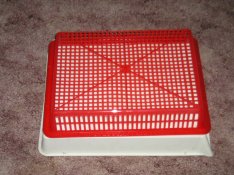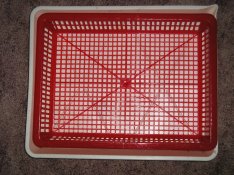If you are using that much liquid, in the vertically stacked idea above, then you could just go over to deep-tanks and hangers to get perfect negs every time. One positive thing about four sheets of 4x5" (or a single 8x10") held in a thin plastic slosher is the relatively low chemical volume needed, for either a 'big' 8x10" tray or a 'small' 9 1/2x12" tray.
Compact deep tanks can leave edge artifacts. I have a nice set of four 1-gallon 8x10 SS tanks housed in a purpose-built SS water jacket tank that I've used with standard hangers for years.
Because the edges of the hangers are just inside the edges of the developing tank (an attempt to minimize solution volume) reflected turbulence causes overdevelopment of the film edges. Especially the vertical edges. This is one reason the standard recommendation when tray developing sheet film is to use a tray that's one format size larger than the target film sheets.
One solution to the artifact problem would be stacked wire basket sloshers. I already simulate this using the standard hangers laid flat in oversized trays for the development step only. After development I transfer them back to the deep tanks for stop, fix, and wash aid. Then suspend them in my 16x20 washer for washing. No artifacts with this method. But only one 8x10 (or four 4x5) sheets per run.*
Another solution may be to DIY-convert the 1-gallon developer deep tank to gaseous burst. As I use one-shot developers I don't believe there's any need for nitrogen. Simple air should work fine. So should manual agitation timing. Both are what happens in the small tank inversion protocols already. This is currently on my to-do list to try.
And a third artifact solution would be to simply use oversized deep tanks. But the solution volumes required in a non-replenished system then become huge.
I have also tried the SS Nikor 4x5 tanks. Using homebrew D-76d at 1+1 leaves serious inner-edge overdevelopment artifacts on 4x5 sheets. This is because upon inversion all of the air inside the tank must bubble up through a small central hole in the sheet cage. This turbulence passes directly over the inner edges of the loaded film sheets. The outer edges do not experience this turbulence.
There is also a problem for me with air bubbles trapped under the top cage plate leaving underdeveloped moving "spots" on the upper sheet edges. This artifact can be somewhat mitigated by adding a few drops of Edwal LFN to the developer to break up the bubbles.
And except for oversized deep tanks, developer solution volumes are inconsequential versus the expenses involved in making the negatives themselves. Especially 8x10 negatives. For me it would be a false economy to even worry about. Gasoline costs far more overall than developer.
So I'm definitely willing to look at SS wire basket sloshers. Very thin wire should leave virtually no artifact footprints.
Ken
* Note that it's also possible to buy and use one of those office-style wire paper trays to develop 8x10 sheets in a tray. Just make sure they are completely sealed with paint, vinyl, or sprayed with something by you. These work nice in 11x14 trays. But only for single sheets of 8x10.














